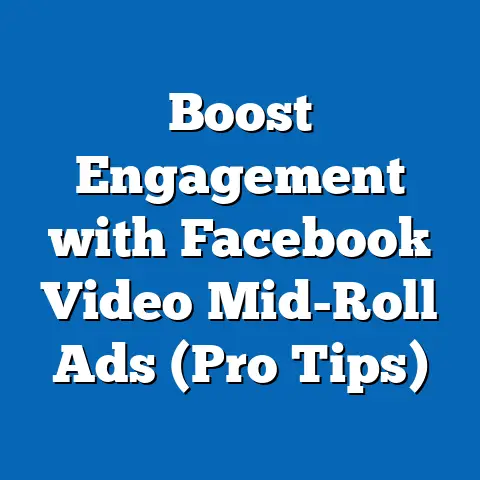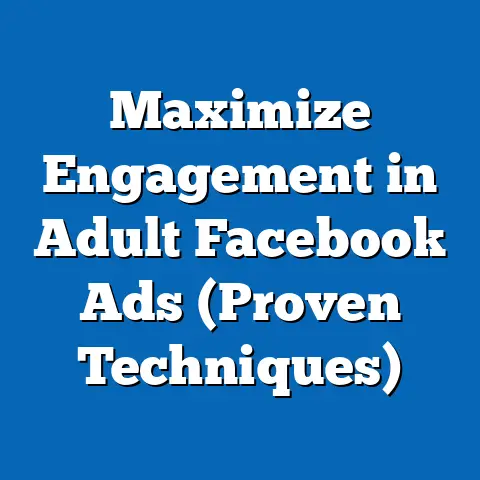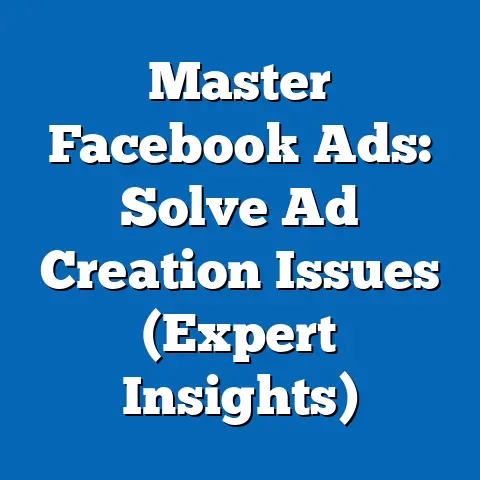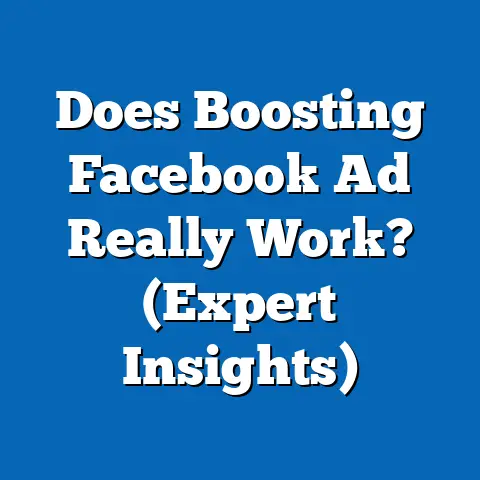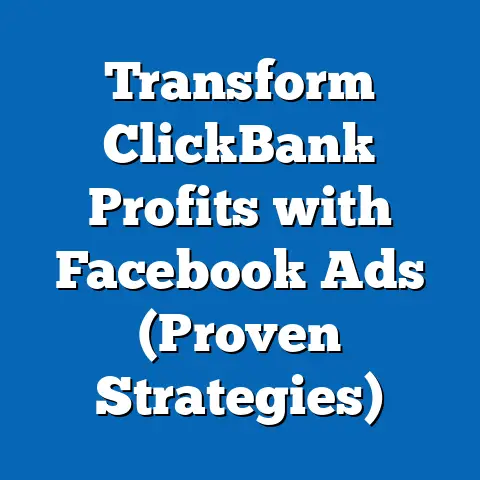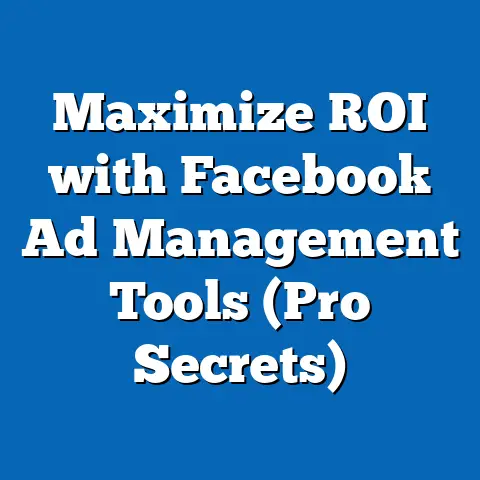Edit Facebook Ad Post-Publication? (Expert Insights)
Imagine you’re planning a grand outdoor event. You’ve meticulously checked the weather forecast, but as the day approaches, the skies turn grey and the forecast shifts to rain. A waterproof plan – a tent, covered walkways, and indoor alternatives – becomes your saving grace. In the dynamic world of Facebook advertising, the ability to adapt and adjust your campaigns after they’re live is just as crucial. It’s like having a “waterproof” strategy for your ads, ensuring they can withstand the ever-changing digital landscape.
I’ve spent years crafting and analyzing Facebook ad campaigns, and one thing has become abundantly clear: the initial launch is just the beginning. The real magic happens in the ongoing optimization, which often involves making edits post-publication. This article delves into the world of Facebook ad editing, exploring why it’s necessary, what you can change, and how to do it effectively.
Understanding Facebook Ads: Your Digital Billboard
Facebook Ads are essentially paid messages that businesses use to reach specific audiences on the Facebook platform. They’re a powerful tool in digital marketing, allowing you to target potential customers with incredible precision based on demographics, interests, behaviors, and more. Think of them as digital billboards, strategically placed to grab the attention of the right people at the right time.
There’s a diverse range of Facebook ad formats, each designed for a specific purpose:
- Image Ads: Simple yet effective, these ads use a single compelling image and concise text to convey your message.
- Video Ads: Engaging and dynamic, video ads capture attention and tell your brand story in a visually appealing way.
- Carousel Ads: Showcase multiple products or services with a series of images or videos in a single ad unit.
- Collection Ads: Designed for e-commerce, these ads feature a hero image or video alongside a selection of related products.
- Lead Ads: Collect valuable leads directly from Facebook users without requiring them to leave the platform.
The typical lifecycle of a Facebook ad begins with meticulous planning. You define your target audience, craft compelling ad copy, select eye-catching visuals, and set your budget. Then, you launch your campaign and wait for the results to roll in. However, this is where many advertisers make a critical mistake: they assume the initial setup is all that’s needed. In reality, the post-publication phase is just as important, if not more so.
The Need for Post-Publication Edits: Adapting to Reality
No matter how carefully you plan, unforeseen circumstances can arise that necessitate editing your Facebook ads after they’ve gone live. Here are a few real-world scenarios I’ve encountered:
- Urgent Situations: Imagine you’re running a promotion for a specific product, but a sudden supply chain issue forces you to temporarily halt sales. You need to quickly update your ad copy to reflect the change, preventing customer frustration and protecting your brand reputation.
- A/B Testing Insights: A/B testing is a powerful technique for optimizing your ads. You create multiple versions of the same ad with slight variations (e.g., different headlines, images, or call-to-actions) and track their performance. The results might reveal that one version significantly outperforms the others, prompting you to edit the underperforming ads to match the winning formula.
- Customer Feedback: Sometimes, your target audience provides valuable feedback directly through comments or messages. They might point out confusing wording, misleading visuals, or irrelevant targeting. This feedback is invaluable for refining your ads and ensuring they resonate with your intended audience. I once ran an ad campaign that was receiving negative comments about the pricing of our product. After reviewing the feedback, we realized that the pricing information in the ad was unclear. We immediately edited the ad to provide more transparent pricing details, which significantly improved customer sentiment and ad performance.
- Changing Market Conditions: The market is constantly evolving, and your ads need to keep pace. New competitors might emerge, consumer trends might shift, or economic conditions might change. Editing your ads to reflect these changes ensures they remain relevant and effective.
Failing to edit your ads when necessary can have significant consequences. Poor performance, wasted ad spend, brand misrepresentation, and even negative customer sentiment are all potential outcomes. In today’s fast-paced digital world, adaptability is key to success, and that includes being able to quickly and effectively edit your Facebook ads.
What Can Be Edited? Unleashing the Power of Flexibility
Fortunately, Facebook provides a good degree of flexibility when it comes to editing your ads after they’ve been published. You can modify various elements to optimize performance and address changing circumstances. Here’s a breakdown of what you can typically edit:
- Text Changes: This includes the headline, description, and call-to-action (CTA). Experiment with different wording to see what resonates best with your audience. For example, try changing your CTA from “Learn More” to “Shop Now” if you’re promoting a product.
- Visual Elements: You can swap out images, videos, or thumbnails to improve the visual appeal of your ads. Consider testing different images to see which ones generate the most clicks and engagement.
- Targeting Options: Refine your targeting by adjusting demographics, interests, locations, or behaviors. If you’re finding that your ads are reaching the wrong audience, narrow your targeting to focus on the most relevant potential customers.
- Budget Adjustments: Increase or decrease your daily or lifetime budget to control your ad spend. If you’re seeing positive results, you might want to increase your budget to reach a wider audience. Conversely, if your ads are underperforming, you might want to reduce your budget to minimize losses.
- Scheduling: Modify the start and end dates of your ad campaign to align with specific events or promotions. You can also adjust the times of day when your ads are shown to reach your audience when they’re most active.
I’ve seen firsthand how impactful these edits can be. In one instance, I was managing a campaign for a local restaurant. The initial ad featured a generic image of their menu items. After analyzing the results, I noticed that the click-through rate was lower than expected. I decided to edit the ad and replace the generic image with a mouthwatering photo of their signature dish. The result was a dramatic increase in click-through rate and a surge in reservations.
Expert Insights and Best Practices: Mastering the Art of Editing
Editing Facebook ads isn’t just about making changes; it’s about making smart changes that drive results. Here are some expert insights and best practices I’ve learned over the years:
- Timing is Everything: Consider the timing of your edits carefully. Avoid making significant changes during peak traffic times, as this could disrupt your campaign’s momentum. Instead, schedule edits for off-peak hours when traffic is lower.
- Data-Driven Decisions: Don’t rely on gut feelings when making edits. Use analytics to guide your decisions. Track key metrics like engagement rate, click-through rate, conversion rate, and return on ad spend (ROAS) to identify areas for improvement.
- A/B Test Your Edits: Before making widespread changes, A/B test your edits to see how they perform. Create a control group and a test group, and compare their results. This will help you determine whether your edits are actually improving your campaign’s performance.
- Communicate with Your Team: Keep your team members informed about any changes you make to your Facebook ads. This will prevent confusion and ensure that everyone is on the same page.
- Don’t Overdo It: While it’s important to be proactive about editing your ads, avoid making too many changes too frequently. This can disrupt your campaign’s performance and make it difficult to track the impact of individual edits.
- Embrace the Learning Process: Facebook advertising is an ongoing learning process. Don’t be afraid to experiment with different strategies and learn from your mistakes. The more you experiment, the better you’ll become at optimizing your campaigns.
I remember one instance where I was working with a client who was hesitant to make any changes to their Facebook ads after they’d been published. They were afraid of disrupting their campaign’s performance. I explained to them that editing their ads was not a sign of failure, but rather an opportunity to optimize their campaigns and improve their results. I convinced them to A/B test a few different headlines, and the results were eye-opening. One headline significantly outperformed the others, leading to a dramatic increase in click-through rate and conversions. This experience taught my client the importance of embracing the flexibility of Facebook advertising and being willing to experiment with different strategies.
Analyzing the Impact of Edits: Measuring Your Success
After making edits to your Facebook ads, it’s crucial to track their performance and measure their impact. This will help you determine whether your edits were successful and whether you need to make further adjustments.
Here are some key performance indicators (KPIs) that you should track:
- Engagement Rate: Measures how much your audience is interacting with your ads (e.g., likes, comments, shares).
- Click-Through Rate (CTR): Measures the percentage of people who see your ad and click on it.
- Conversion Rate: Measures the percentage of people who take a desired action after clicking on your ad (e.g., making a purchase, filling out a form, or signing up for a newsletter).
- Return on Ad Spend (ROAS): Measures the revenue generated for every dollar spent on advertising.
Facebook Ads Manager provides a wealth of data and analytics that you can use to track these metrics. Use this data to identify trends, patterns, and areas for improvement.
For example, if you notice that your click-through rate has increased after editing your headline, that’s a good indication that your new headline is more effective. However, if your conversion rate has decreased, you might need to make further adjustments to your ad copy or landing page.
Conclusion: Embrace the Power of Adaptability
Just like a waterproof plan protects your outdoor event from unexpected rain, the ability to edit your Facebook ads post-publication protects your advertising campaigns from the ever-changing digital landscape. It’s not a sign of failure, but rather an opportunity to optimize your campaigns, improve your results, and align your advertising efforts with real-time market conditions and audience preferences.
I encourage you to embrace the flexibility offered by Facebook Ads and use it to your advantage. Don’t be afraid to experiment with different strategies, track your results, and make adjustments as needed. With a data-driven approach and a willingness to adapt, you can master the art of Facebook advertising and achieve greater success in your campaigns. So, go forth and edit! Your ads, and your ROI, will thank you for it.

